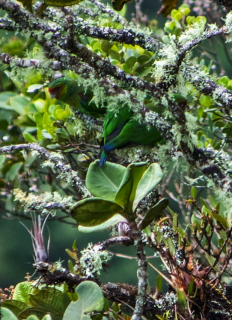Red-faced Parrot |
|
|
Photos
View in GalleryDid You Know?
This parrot is usually solitary or in the breeding season seen in pairs.Programs & Projects
WPT has worked with numerous partners to help save this species. Learn moreAcademic Research
Related publications: Hapalopsittaca pyrrhopsSpecies Profile
Genus: Hapalopsittaca | Species: pyrrhops
Size:
23cm (9 in)
Weight:
Probably as in Rusty-faced Parrot: 97-115g (3.4-4 oz).
Subspecies including nominate:
one
Colour Adult:
Both adults: dark red forehead and lores to area in front of cheeks and chin; crown and nape green with tint of blue; area behind cheeks and ear-coverts green, with green/yellow shafts; various feathers of abdomen tipped red. Bend of wing and carpal edge to lesser, outer middle and lesser underwing coverts deep red; tail green tipped purple. Bill horn-coloured with blue/grey base of upper mandible. Eye green/yellow.
Colour Juvenile:
As in adults but duller; duller red on face and bend of wing to lesser wing coverts.
Call:
Described as generally harsh and screechy. Two syllable calls. First part is rasping, second part higher-pitched. Will give calls while perched or feeding. Young sound different-chattering and laugh-like.
Listen NowMore Information:
Content Sources:
CITES
BirdLife International
Cornell Lab of Ornithology/Birds of the World
A Guide to Parrots of the World, Juniper and Parr, 1998
ML Media Collection Catalogue 65992, Red-faced Parrot Hapalopsittaca pyrrhops, Krabbe, Niels, Loja, Ecuador, Nov. 11 1992, Cornell Lab of Ornithology. Site
Parrots: Status Survey and Conservation Plan 2000-2004, Snyder, McGowan, Gilardi and Grajal, 2000.
Parrots of the World, Forshaw, 2006. 2010 edition
Photos
View in GalleryDid You Know?
This parrot is usually solitary or in the breeding season seen in pairs.Programs & Projects
WPT has worked with numerous partners to help save this species. Learn moreAcademic Research
Related publications: Hapalopsittaca pyrrhopsSpecies Care
Captive Status:
Unknown in aviculture.
Longevity:
Not recorded.
Housing:
Not recorded.
Diet:
Not recorded.
Enrichment:
Not recorded.
Nest Box Size:
Not recorded.
Clutch Size:
3
Incubation Time:
Not recorded.
Fledging Age:
Not recorded.
Hatch Weight:
Not available
Peak Weight:
Not recorded.
Weaning Weight:
Not recorded.
Photos
View in GalleryDid You Know?
This parrot is usually solitary or in the breeding season seen in pairs.Programs & Projects
WPT has worked with numerous partners to help save this species. Learn moreAcademic Research
Related publications: Hapalopsittaca pyrrhopsSpecies Wild Status
World Population:
10,000-37,000 mature individuals, decreasing.
IUCN Red List Status:
Least Concern
CITES Listing:
Appendix II
Threat Summary:
A BirdLife “restricted-range” species. Very uncommon and local in Ecuador due to near-total deforestation at the elevation they live. Also rare in Peru.
Range:
Found on the slopes of the Andes in N Peru and S Ecuador.
Habitat:
Found from 2400-3500m (7872-11,480 ft). Inhabits wet upper montane forest in the temperate zone including mossy growth areas, open woodlands and shrubbery. Also reported in fragmented forest with varying degrees of degradation. Will tolerate secondary forest.
Wild Diet:
Feeds on Miconia fruits, Viburnum berries, Weinmannia shoots, flowers and seeds, Clethra flowers and pods, and parts of Ericaceous trees Cavendishia and Disterigma.
Ecology and Behaviour:
Gregarious, almost always seen in flocks of up to 20 birds. Resident, with local movements in response to food availability.
Clutch and Egg Size:
3 eggs
Breeding Season:
October–January, possibly also August. Nest is in cavity in tree.
Related Links:
Photos
View in GalleryDid You Know?
This parrot is usually solitary or in the breeding season seen in pairs.Programs & Projects
WPT has worked with numerous partners to help save this species. Learn moreAcademic Research
Related publications: Hapalopsittaca pyrrhopsMembers Only Resources
Please log-in now to find more research, resources and tools.
Not a Member?
Find more great information:
Gain exclusive access to 600+ pages of additional research, seminars and podcasts, specialists to ask your toughest questions, and dozens of other fun resources - when you become a WPT member.
Join Today >>

































